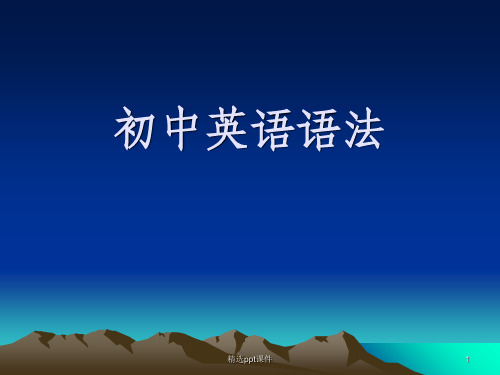初中英语语法讲解课件
合集下载
初中英语语法课件ppt

02
Concrete nouns
These nouns represent a tangible object or person that can be
seen or touched For example: book, car, person
03
Collective nouns
These nouns name a group of people or things considered as a
whole For example: family, team, herd
The Plural Form Nouns
English nouns have a plural form that is used to refer to more than one person, thing, or idea
class of things
Types of Nouns
01
Abstract nouns
These nouns rconcept that
cannot be touched or seen For example: love, fear, justice
animal, or idea
Nouns can be classified into two main categories: normal nouns and common nouns
Prop nouns name specific individuals, places, or things while common nouns name a
02
Verb
Definition of verbs
Definition of verb
初中英语零基础学语法--英语句子结构 课件(共43张PPT)

附属成分
基本成分的修饰语。可以是: • 定语:即用来修饰名词的单词、短语或从句 • 状语:即用来修饰名词或代词以外的词的单词、短语或从句。
定语
Poor John tottered toward a hospital nearby. She likes oranges imported from the USA.
省略成分
句中被省略的成分,虽然未说出来,却在句中表示 一定的意思:
(You) Come here. (I wish you)Good luck! Some gave him praises,but others(gave him)rotten eggs.
He runs as fast as, if ( he does ) not ( run ) faster, than you. ( I ) Hope you like it. John should clean the room today and Peter ( should clean it ) tomorrow.
主语、动词(不及物动词、及物动词、双宾动词、系动词、宾 补动词)、宾语及补语可以称为基本句子成分。完整的句子一 般至少包含2个基本成分,至多4个基本成分。
Vi(不及物动词)
主 语
谓 语
Vt(及物动词)
宾语 宾语(直) 宾语(间) 宾语 宾补
系动词
表语
be / feel / seem / look appear / stand / lie become /get / grow / turn go / come / remain/ keep taste / smell etc.
连接成分
连接成分实际上是一个连词,用来连接两个或几个平行的词、
初中英语语法讲解PPT课件

双重所有格(of+’s的两种结合)
• P11-13 (textbook) • 做练习 • 作业 列出有关名词一讲疑惑不解或易错的5- 10个难点.
第二讲 冠词和数词
•
冠词是虚词,本身不能单独使用,也没有词义,它用在名词的前面,帮助指明名词 的含义。英语中的冠词有三种,一种是定冠词(the Definite Article),另一种是不定 冠词(the Indefinite Article),还有一种是零冠词(Zero Article)。 2.1不定冠词的用法 不定冠词a (an)与数词one 同源,是"一个"的意思。a用于辅音音素前,一般读作 [e],而an则用于元音音素前,一般读做[en]。 1) 表示"一个",意为one;指某人或某物,意为a certain。 A Mr. Ling is waiting for you.
2) 以o 结尾的名词,变复数时: a. 加s,如: photo---photos piano---pianos radio---radios zoo---zoos; b. 加es,如:potato--potatoes tomato--tomatoes c. 均可,如:zero---zeros / zeroes 3) 以f或fe 结尾的名词变复数时: a. 加s,如: belief---beliefs roof---roofs safe---safes gulf---gulfs; b. 去f,fe 加ves,如:half---halves knife---knives leaf---leaves wolf---wolves wife---wives life---lives thief---thieves; c. 均可,如: handkerchief: handkerchiefs / handkerchieves
初中英语语法课件ppt

vacation together.
过去将来时的使用:
一、过去将来时表示对于过去某一时间而言将要发生的动 作或存在的状态。 would或was /were going to + V
would可用于各种人称。
二、would +V还可表示过去的习惯动作,在这点上同used to同义。
When we were children, we would/used to go swimming every summer.
e) 用于条件从句“如果……想,设想”(接近if ……want to,或 if ……should) 例:Greater efforts to increase agricultural production must be made if food shortage ____________ avoided. A) is to be B) can be C) will be D) has been
一般现在时的动词形式: 动词原形 1.am;is ;are 2.have,has 3.第三人称单数形式-(e)s
肯定句:I watch television every day.
否定句:I don’t watch television every day.
疑问句:Do you watch television every day.
一般现在时的使用:
1.一般现在时表示总是、通常、习惯 性的动作或状态。
It snows in winter. I watch television every day.
2.用于对客观事实的普遍性的陈述。
Water consists of hydrogen and oxygen. Most animals kill only for food. The world is round.
过去将来时的使用:
一、过去将来时表示对于过去某一时间而言将要发生的动 作或存在的状态。 would或was /were going to + V
would可用于各种人称。
二、would +V还可表示过去的习惯动作,在这点上同used to同义。
When we were children, we would/used to go swimming every summer.
e) 用于条件从句“如果……想,设想”(接近if ……want to,或 if ……should) 例:Greater efforts to increase agricultural production must be made if food shortage ____________ avoided. A) is to be B) can be C) will be D) has been
一般现在时的动词形式: 动词原形 1.am;is ;are 2.have,has 3.第三人称单数形式-(e)s
肯定句:I watch television every day.
否定句:I don’t watch television every day.
疑问句:Do you watch television every day.
一般现在时的使用:
1.一般现在时表示总是、通常、习惯 性的动作或状态。
It snows in winter. I watch television every day.
2.用于对客观事实的普遍性的陈述。
Water consists of hydrogen and oxygen. Most animals kill only for food. The world is round.
初中英语语法ppt课件

04
Positions and connections
The usage of commonly used positions
At
used to indicate a specific point in time or place
In
used to indicate a period of time or a location within a larger space
Nouns that cannot be counted or have a plural form. Example: "I have some sugar in the cupboard."
The positive case of nouns
Passive nouns
Nouns that show session or ownership They are formed by adding's to the end of the noun Example: "The teacher's book"
Example
"The cat is bigger than the dog." - "bigger" is the comparative degree of the objective "big."
Formations
The comparative degree of advisors and advisors typically end with "- er" or "- ier", or can be formed by using the suffix "- er" or "- more"
初中英语语法大全精品PPT课件

多时,谓语用复数。 如:There is a sheep in the yard.(院子里有只绵羊)
There are some sheep in the yard.(院子里有一些绵羊) 4、maths, news等虽然有s结尾,但不是复数,因此谓语仍用单数: 如:The news is very exciting. (这个消息令人兴奋)
[注解]:
① ‘s还可以表示某人的家或者某个店铺, 如:my aunt’s(我阿姨家), the doctor’s(诊所)
② 两人共有某物时,可以采用 A and B’s 的形 如:Lucy and Lily’s bedroom(露西和丽丽合住的卧室)
Lucy’s and Lily’s bedroom(露西和丽丽分别的卧室)
如果表示整体概念,则谓语用单数形式, 如:Class Three is a very good class.(三班是好班) 如果表示其中的所有成员时,则谓语用复数形式, 如:Class Three have a map of China.(三班有张中国地图) 3、Chinese, Japanese, fish, sheep, people等表示单个时谓语用单数,表示许
如: box, child, orange;
不可数名词{u} 是不可以用简单的数词进行计数的名词。
如:water, news, oil, population, information .
英语可数名词的单复数
1、名词由单数变复数的基本方法如下: ①在单数名词词尾加s。 如:map → maps,boy→ boys,horse→ horses, table→ tables. ②s,o,x ,sh,ch结尾的词加es. 如:class→classes, box→boxes, hero→heroes, dish→dishes,
There are some sheep in the yard.(院子里有一些绵羊) 4、maths, news等虽然有s结尾,但不是复数,因此谓语仍用单数: 如:The news is very exciting. (这个消息令人兴奋)
[注解]:
① ‘s还可以表示某人的家或者某个店铺, 如:my aunt’s(我阿姨家), the doctor’s(诊所)
② 两人共有某物时,可以采用 A and B’s 的形 如:Lucy and Lily’s bedroom(露西和丽丽合住的卧室)
Lucy’s and Lily’s bedroom(露西和丽丽分别的卧室)
如果表示整体概念,则谓语用单数形式, 如:Class Three is a very good class.(三班是好班) 如果表示其中的所有成员时,则谓语用复数形式, 如:Class Three have a map of China.(三班有张中国地图) 3、Chinese, Japanese, fish, sheep, people等表示单个时谓语用单数,表示许
如: box, child, orange;
不可数名词{u} 是不可以用简单的数词进行计数的名词。
如:water, news, oil, population, information .
英语可数名词的单复数
1、名词由单数变复数的基本方法如下: ①在单数名词词尾加s。 如:map → maps,boy→ boys,horse→ horses, table→ tables. ②s,o,x ,sh,ch结尾的词加es. 如:class→classes, box→boxes, hero→heroes, dish→dishes,
初中英语语法专题课件完整版(共983张PPT)

2.不规则变化
构成方法
例词
形式不变 (单复数同形)
sheep-sheep deer-deer Chinese-Chinese Japanese-Japanese
变内部元音字母
foot-feet tooth-teeth goose-geese man-men mouse-mice
词尾加-en/-ren
a group of 一队,一组,一群
②还可用much,little,a little of,a large amount/deal of, no,plenty of等来修饰不可数名词,some,any既可修饰可数名词也可修 饰不可数名词。
much money,plenty of water a little of air some(肯定句): some milk ,some apples any(疑/否):Are there any stamps?I don’t have any money (5)数词-名词-形容词构成的复合形容词,中间的名词不能用
普通名词又可分为下面四类:
1)个体名词:表示单个人或单个事物。 如:gun、kid 、book。 2)集体名词:表示一群人或一些事物组成的集合体。 如:family。
3)物质名词:表示无法分为个体的物质、材料、食品、饮料、液体、气体、 金属等名称的名词,
如:pork、wood、bread、water、air。 4)抽象名词:表示动作、状态、品质、感情等抽象概念及学科、疾病。 如:work 。Hunger、honesty 、love、Chinese、success、HIV。 个体名词和集体名词可以用数目来计算,称为可数名词。
f,fe 为v,再加 -es
shelf-shelves thief-thieves
初中英语语法ppt课件

• (2)当主动句的宾语是反身代词或相互代词时,这种主 动句不可变为被动句。因为反身代词和相互代词通常不可 以做主语。如:
• He hurt himself.→*Himself hurt is by him.
• We should help each other.→*Each other should be helped.
精选ppt课件
8
第五章 代词
• 注意事项 • (1)当人称代词在分裂句中作中心成分时,常用作主格。
• It is he who did it. • 但在非正式语体中也可用宾格。
• It is me that did it. • (2)当句子主语为“everybody/nobody+but/except+人称代词”的
学校的时候不会弹钢琴。 • (3)表示可能性。 • A gas can be turned into a liquid.气体(可)能转化为液体。 • (4)表示许可, 在非正式场合,可以代替may。 • You can go home now.你现在可以回家了。
精选ppt课件
16
must/have to
• sheep-sheep deer-deer fish-fish JapaneseJapanese
• Chinese-Chinese
精选ppt课件
6
第四章 限定词
• 限定词分前中后,倍数分数是 前位,冠词算是中位词,还有指代 和物代;基数序数相关词,都作后 位限定词。前位中位只一个,后位 可以有多个。
• (4)知觉全部上:feel,hear,watch, see,observe,notice。
精选ppt课件
22
• 后接动词不定式作宾语补足语省略不定式 符号“to”的一些常用特殊词:
• He hurt himself.→*Himself hurt is by him.
• We should help each other.→*Each other should be helped.
精选ppt课件
8
第五章 代词
• 注意事项 • (1)当人称代词在分裂句中作中心成分时,常用作主格。
• It is he who did it. • 但在非正式语体中也可用宾格。
• It is me that did it. • (2)当句子主语为“everybody/nobody+but/except+人称代词”的
学校的时候不会弹钢琴。 • (3)表示可能性。 • A gas can be turned into a liquid.气体(可)能转化为液体。 • (4)表示许可, 在非正式场合,可以代替may。 • You can go home now.你现在可以回家了。
精选ppt课件
16
must/have to
• sheep-sheep deer-deer fish-fish JapaneseJapanese
• Chinese-Chinese
精选ppt课件
6
第四章 限定词
• 限定词分前中后,倍数分数是 前位,冠词算是中位词,还有指代 和物代;基数序数相关词,都作后 位限定词。前位中位只一个,后位 可以有多个。
• (4)知觉全部上:feel,hear,watch, see,observe,notice。
精选ppt课件
22
• 后接动词不定式作宾语补足语省略不定式 符号“to”的一些常用特殊词:
- 1、下载文档前请自行甄别文档内容的完整性,平台不提供额外的编辑、内容补充、找答案等附加服务。
- 2、"仅部分预览"的文档,不可在线预览部分如存在完整性等问题,可反馈申请退款(可完整预览的文档不适用该条件!)。
- 3、如文档侵犯您的权益,请联系客服反馈,我们会尽快为您处理(人工客服工作时间:9:00-18:30)。
名词复数的不规则变化
1)child---children foot---feet
tooth---teeth
mouse---mice
man---men
woman---women
注意:与 man 和 woman构成的合成
词,其复数形式也是 -men 和-women。
如: an Englishman,two
1.2名词复数的规则变化(P5)
____________________________
_______________________
情况 构成方法 读音
例词
____________________________
______________________
一般情况
加 -s 1.清辅音后读
/s/; map-maps
蛋糕是一种食物。 (不可数) These cakes are sweet.
这些蛋糕很好吃。 (可数) b. 当物质名词表示该物质的种类时,
名词可数。 This factory produces steel.
(不可数) We need various steels. (可数)
c. 当物质名词表示份数时,可数。
2) man, woman, gentleman等作定 语时,其单复数以所修饰的名词的单复数
3) 有些原有s结尾的名词,作定语时,s保留。 如:goods train (货车) arms produce 武器生产 customs papers 海关文件 clothes brush衣刷
4) 数词+名词作定语时,这个名词一般保留单数形式。 如:two-dozen eggs 两打/(二十四个鸡蛋) a ten-mile walk 十里路 two-hundred trees 两百棵树 a five-year plan 一个五年计划
English Grammar
第一讲 名词
1.1名词的分类 名词可以分为专有名词(Proper Nouns)
和普通名词 (Common Nouns),专有 名词是某个(些)人,地方,机构等专 有的名称,如Beijing,China等。普通 名词是一类人或东西或是一个抽象概念 的名词,如:book,sadness等。普通 名词又可分为下面四类:
1.4复合名词的复数形式(P9)略
1.5 名词作定语 名词作定语一般用单数,但也有以下例外。
1) 用复数作定语。 如:sports meeting 运动会 students reading-room 学生
阅览室 talks table 谈判桌 the foreign languages
department 外语系
专有名词s结尾(一般应加’s) Charles’s job 2) 若名词已有复数词尾-s ,只
双重所有格(of+’s的两种结合)
P11-13 (textbook) 做练习 作业
列出有关名词一讲疑惑不解或易错的5- 10个难点.
第二讲 冠词和数词
冠词是虚词,本身不能单独使用,也没 有词义,它用在名词的前面,帮助指明名 词的含义。英语中的冠词有三种,一种是 定冠词(the Definite Article),另一种 是不定冠词(the Indefinite Article), 还有一种是零冠词(Zero Article)。
2) 以o 结尾的名词,变复数时: a. 加s,如: photo---photos piano---pianos radio---radios zoo---zoos; b. 加es,如:potato--potatoes tomato--tomatoes c. 均可,如:zero---zeros / zeroes
1)个体名词(Individual Nouns): 表示某类人或东西中的个体,如:gun。
2)集体名词(Collective Nouns): 表示若干个个体组成的集合体,如:
归纳表格如下
| |专有名词 |
|
|名 |
| 个体名词
|
||
|
|
||
| 集体名词|| |普 Nhomakorabea名词 |
|
| | 可数名词 | |
1.6名词的格
在英语中有些名词可以加’s来表示所有 或所属关系,带这种词尾的名词形式称 为该名词的所有格,如:a teacher’s book。名词所有格的规则如下:(修饰 有生命的名词用’s,无生命的一般用of 结构)
1) 单数名词词尾加 ’s,复数名词词 尾没有s,也要加‘s,如the boy’s bag 男孩的书包,men‘s room 男厕所。
Nations 应视为单数。 The United Nations was
organized in 1945. 联合国是1945年组 建起来的。
d. 以复数形式出现的书名,剧名, 报纸,杂志名,也可视为单数。
"The Arabian Nights" is a very
1.3不可数名词量的变化
物质名词 a. 当物质名词转化为个体名词时。 比较: Cake is a kind of food.
Englishmen. 但German不是合成词,
故复数形式为Germans;Bowman是
姓,其复数是the Bowmans。
不规则变化
4)以s结尾,仍为单数的名词,如: a. maths,politics,physics等学
科名词,为不可数名词,是单数。 b. news 是不可数名词。 c. the United States,the United
3) 以f或fe 结尾的名词变复数时: a. 加s,如: belief---beliefs roof---roofs safe---safes gulf---gulfs; b. 去f,fe 加ves,如:half---halves knife---knives leaf---leaves wolf---wolves wife---wives life---lives thief---thieves; c. 均可,如: handkerchief:
2.浊辅音和元
音后 bag-bags
读 /z/;
) 以y 1结尾的专有名词,或元音字母+y 结尾的名
词变复数时, 直接加s变复数:
如: two Marys
the Henrys
monkey---monkeys holiday---holidays
比较: 层楼:storey ---storeys story---stories
